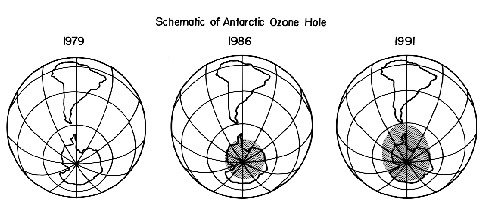A .gov website belongs to an official government organization in the United States.
A lock () or https:// means you've safely connected to the .gov website. Share sensitive information only on official, secure websites.

Human emissions of CFCs do occur mainly in the Northern Hemisphere, with about 90% released in the latitudes corresponding to Europe, Russia, Japan, and North America. Gases such as CFCs that are insoluble in water and relatively unreactive are mixed within a year or two throughout the lower atmosphere (below about 10 km). The CFCs in this well-mixed air rise from the lower atmosphere into the stratosphere mainly in tropical latitudes. Winds then move this air poleward - both north and south - from the tropics, so that air throughout the stratosphere contains nearly the same amount of chlorine. However, the meteorologies of the two polar regions are very different from each other because of major differences at the Earth's surface. The South Pole is part of a very large land mass (Antarctica) that is completely surrounded by ocean. These conditions produce very low stratospheric temperatures which in turn lead to formation of clouds (polar stratospheric clouds). The clouds that form at low temperatures lead to chemical changes that promote rapid ozone loss during September and October of each year, resulting in the ozone hole.
In contrast, the Earth's surface in the northern polar region lacks the land/ocean symmetry characteristic of the southern polar area. As a consequence, Arctic stratospheric air is generally much warmer than in the Antarctic, and fewer clouds form there. Therefore, the ozone depletion in the Arctic is much less than in the Antarctic.
